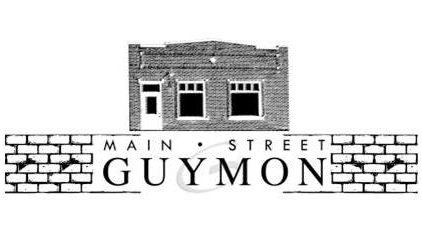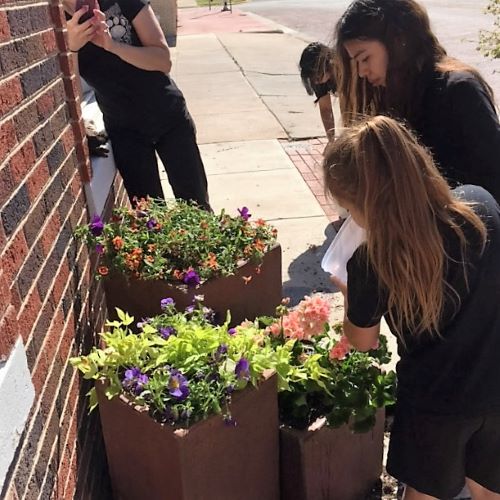Main Street Guymon Mission Statement: Promoting the history, culture, and commerce of downtown Guymon and the surrounding areas.
Vision: Connecting businesses, encouraging historic preservation, and engaging the local community to create a diverse and vibrant culutre, providing social, educational, and economic activities.

About the Main Street Movement:
Over the past 30 years, the Main Street movement has transformed the way communities think about the revitalization and management of their downtowns and neighborhood commercial districts. Cities and towns across the nation have come to see that a prosperous, sustainable community is only as healthy as its core.
The Main Street Four-Point Approach® is a unique preservation-based economic development tool that enables communities to revitalize downtown and neighborhood business districts by leveraging local assets – from historic, cultural, and architectural resources to local enterprises and community pride. It is a comprehensive strategy that addresses the variety of issues and problems that challenge traditional commercial districts.
As a unique economic development tool, the Main Street Four-Point Approach® is the foundation for local initiatives to revitalize their districts by leveraging local assets—from cultural or architectural heritage to local enterprises and community pride.
The four points of the Main Street approach work together to build a sustainable and complete community revitalization effort. They are Organization, Promotion, Design, and Economic Reconstruction.
Organization:
Organization establishes consensus and cooperation by building partnerships among the various groups that have a stake in the commercial district. By getting everyone working toward the same goal, your Main Street program can provide effective, ongoing management and advocacy for our downtown district. Through volunteer recruitment and collaboration with partners representing a broad cross section of the community, your program can incorporate a wide range of perspectives into its efforts. A governing board of directors and standing committees make up the fundamental organizational structure of volunteer-driven revitalization programs. Volunteers are coordinated and supported by a paid program director. This structure not only divides the workload and clearly delineates responsibilities, but also builds consensus and cooperation among the various stakeholders.
Promotion:
Promotion takes many forms, but the goal is to create a positive image that will rekindle community pride and improve consumer and investor confidence in our commercial district. Advertising, retail promotions, special events, and marketing campaigns help sell the image and promise of Main Street to the community and surrounding region. Promotions communicate our commercial district’s unique characteristics, business establishments, and activities to shoppers, investors, potential business and property owners, and visitors.
Design:
Design means getting Main Street into top physical shape and creating a safe, inviting environment for shoppers, workers, and visitors. It takes advantage of the visual opportunities inherent in a commercial district by directing attention to all of its physical elements: public and private buildings, storefronts, signs, public spaces, parking areas, street furniture, public art, landscaping, merchandising, window displays, and promotional materials. An appealing atmosphere, created through attention to all of these visual elements, conveys a positive message about the commercial district and what it has to offer. Design activities also include instilling good maintenance practices in the commercial district, enhancing the district’s physical appearance through the rehabilitation of historic buildings, encouraging appropriate new construction, developing sensitive design management systems, educating business and property owners about design quality, and long-term planning.
Economic Restructuring:
Economic restructuring strengthens your community’s existing economic assets while diversifying its economic base. This is accomplished by retaining and expanding successful businesses to provide a balanced commercial mix, sharpening the competitiveness and merchandising skills of business owners, and attracting new businesses that the market can support. Converting unused or underused commercial space into economically productive property also helps boost the profitability of the district. The goal is to build a commercial district that responds to the needs of today’s consumers.
View Business Development Committee.
Coincidentally, the four points of the Main Street approach correspond with the four forces of real estate value, which are social, political, physical, and economic.
The Eight Principles:
The National Main Street Center’s experience in helping communities bring their commercial corridors back to life has shown time and time again that the Main Street Four-Point Approach succeeds. That success is guided by the following eight principles, which set the Main Street methodology apart from other redevelopment strategies. For a Main Street program to be successful, it must whole-heartedly embrace the following time-tested Eight Principles.
Also read: The Four Points
- Comprehensive: No single focus — lavish public improvements, name-brand business recruitment, or endless promotional events — can revitalize Main Street. For successful, sustainable, long-term revitalization, a comprehensive approach, including activity in each of Main Street’s Four Points, is essential.
- Incremental: Baby steps come before walking. Successful revitalization programs begin with basic, simple activities that demonstrate that “new things are happening ” in the commercial district. As public confidence in the Main Street district grows and participants’ understanding of the revitalization process becomes more sophisticated, Main Street is able to tackle increasingly complex problems and more ambitious projects. This incremental change leads to much longer-lasting and dramatic positive change in the Main Street area.
- Self-help: No one else will save your Main Street. Local leaders must have the will and desire to mobilize local resources and talent. That means convincing residents and business owners of the rewards they’ll reap by investing time and money in Main Street — the heart of their community. Only local leadership can produce long-term success by fostering and demonstrating community involvement and commitment to the revitalization effort.
- Partnerships: Both the public and private sectors have a vital interest in the district and must work together to achieve common goals of Main Street’s revitalization. Each sector has a role to play and each must understand the other’s strengths and limitations in order to forge an effective partnership.
- Identifying and capitalizing on existing assets: Business districts must capitalize on the assets that make them unique. Every district has unique qualities like distinctive buildings and human scale that give people a sense of belonging. These local assets must serve as the foundation for all aspects of the revitalization program.
- Quality: Emphasize quality in every aspect of the revitalization program. This applies to all elements of the process — from storefront designs to promotional campaigns to educational programs. Shoestring budgets and “cut and paste” efforts reinforce a negative image of the commercial district. Instead, concentrate on quality projects over quantity.
- Change: Skeptics turn into believers and attitudes on Main Street will turn around. At first, almost no one believes Main Street can really turn around. Changes in attitude and practice are slow but definite — public support for change will build as the Main Street program grows and consistently meets its goals. Change also means engaging in better business practices, altering ways of thinking, and improving the physical appearance of the commercial district. A carefully planned Main Street program will help shift public perceptions and practices to support and sustain the revitalization process.
- Implementation: To succeed, Main Street must show visible results that can only come from completing projects. Frequent, visible changes are a reminder that the revitalization effort is under way and succeeding. Small projects at the beginning of the program pave the way for larger ones as the revitalization effort matures, and that constant revitalization activity creates confidence in the Main Street program and ever-greater levels of participation.

